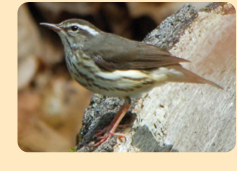 |
|||
|
|
|||
|
 What Species: Louisiana Waterthrush (Seiurus motacilla) What Species: Louisiana Waterthrush (Seiurus motacilla)
Where: Laurel Highlands of Western Pennsylvania, and the Cordillera Septentrional of the Dominican Republic Who: Dr. Steven Latta (National Aviary), Robert Mulvihill (Powdermill Avian Research Center, Carnegie Museum of Natural History), and Danilo Mejía and Marisabel Paulino (Sociedad Ornitológica de la Hispaniola) When: 2007 - present. Why: Research into terrestrial bird population declines has often focused on fragmentation of forest habitats and conversion of habitats for agricultural or urban land uses. The causes of population declines of riparian birds (those associated with stream-side vegetation) are likely to be different and varied, but land uses resulting in sedimentation, acidification, and degradation of aquatic insect communities may be critical to the conservation of these bird species. We are studying the ecology of the Louisiana Waterthrush on the breeding and wintering grounds, identifying landscape-level factors, territory characteristics, and specific stream quality measures associated with reproductive success and over-winter survival, and assessing the use of birds as indicators of water quality and ecosystem health. We are also assessing the connectivity of wintering populations to breeding populations through isotopic markers, and providing the basis for studies of carryover effects of habitat conditions Current Goals:
Next Steps: Work is on-going. Page 2 Listen to a broadcast from the Allegheny Front – Environmental Radio for Western Pennsylvania 
|



 Compare LOWA presence, territory size, density, site fidelity, and return rates to biotic indices or other measures of riparian habitat quality, including landscape-level land use, territory characteristics, macroinvertebrate assemblages, water chemistry, and other physical variables at over-wintering sites in the Dominican Republic;
Compare LOWA presence, territory size, density, site fidelity, and return rates to biotic indices or other measures of riparian habitat quality, including landscape-level land use, territory characteristics, macroinvertebrate assemblages, water chemistry, and other physical variables at over-wintering sites in the Dominican Republic;
